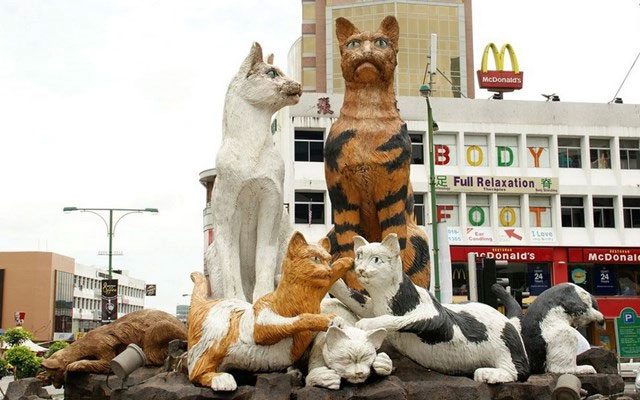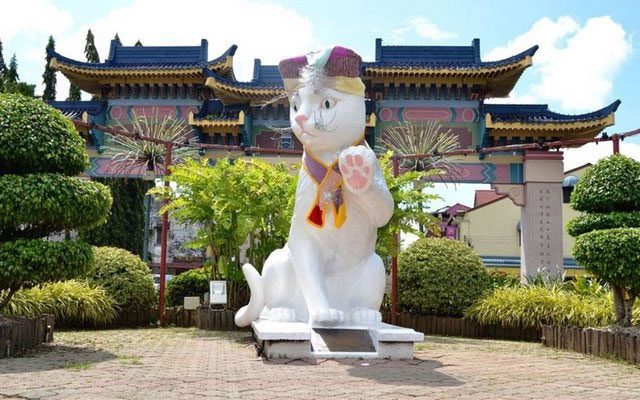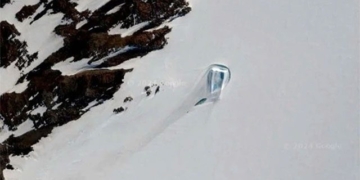When compared to other species in the symbol of the 12 zodiac animals, dogs and cats can be considered the two closest animals to humans.
Among them, when mentioning cats, people often think of an image of a clever, quick-witted creature, possessing the strength of a carnivore but also the gentle, adorable traits of a pampered pet.
In daily life, humans are also familiar and friendly with cats. The image of cats in culture and in people’s minds is very diverse and unique, with distinct expressions of their ability to adapt, flexibility in life, and especially the perseverance and patience that are unique traits of cats, which not every animal possesses.
In Malaysia, cats are even named after a city known as “Kuching – the City of Cats.”
No one knows exactly why Kuching was named after a cat, but the presence of cats can be felt all over the city, from street names to landmarks around the city.

Kuching – The City of Cats, a Promised Land of Malaysia.
The Origin of Kuching
Although known as the “City of Cats” with cat imagery present on every street corner, no one truly knows how the name Kuching originated.
The most widely accepted hypothesis is that the name Kuching is closely tied to the British explorer James Brooke. When he first arrived in Kuching aboard his ship, the Royalist, James Brooke asked a local guide about the name of the place he had landed.
However, at that moment, the guide thought he was pointing at a cat, and thus responded with “Kuching,” which in Malay means cat. From that point on, a hypothesis about the origin of the city’s name was born.
Another theory suggests that the name may originate from a branch of the Sarawak River or a local fruit called mata kuching, which means cat’s eye.

Cats appear everywhere in Kuching.
Another legend states that in the 1950s, many people in Sarawak, Borneo, died from malaria. To address this, authorities spread large amounts of DDT insecticide.
While this pesticide helped the community combat malaria-carrying mosquitoes, it also killed a significant number of cats on the island. The consequence was a booming rat population, which brought about the plague.
To solve this issue, the Royal Air Force of the United Kingdom dropped 14,000 cats into rural Borneo, Malaysia, in a mission known as “Operation Cat Drop.”
Although this story remains unverified, it became so famous that it is believed to be one of the reasons why the United States Senate banned DDT in 1972.
While the exact origin of the city’s name remains a matter of hypothesis, Kuching has officially been known as the City of Cats since 1988, and gradually, many of its urban landmarks have been inspired by cats.
Interesting Aspects of the City of Cats
In Kuching, cats are found everywhere, from felines in cafes to giant cat statues, street art, and especially a dedicated cat museum spanning over 1,000 square meters, built in 1987.
Regarding the relationship between the local population and cats, it is known that Kuching is a multicultural city, home to many Malays, Chinese, and Indians, as well as local tribes such as the Iban, Bidayuh, Orang Ulu, and Melanau.
Moreover, cats hold significant meaning for each ethnic group living in Kuching. For the Chinese, cats are symbols of luck. For centuries, cats have also been revered by Muslims – the dominant religion among indigenous tribes on Borneo. The Prophet Muhammad owned a cat named Muezza.
Additionally, the residents of Borneo love cats because they help control pests, as mentioned in the previous legend. At roundabouts and intersections, many cat statues are erected to attract tourists’ attention and to protect the city, as Malaysians believe cats bring good fortune. At the entrance to the city center, there is a giant white cat statue.
The image of cats deeply permeates the lives of Kuching’s residents. Cat monuments are found everywhere, in various shapes, sizes, colors, materials, states, and strikingly vivid. Cats are present on streets, squares, parks, as well as in shops, offices, and homes. There is even a school named after cats (I CATS – International College of Technology Sarawak).
CATS FM is the local radio station… At the highest point of the city, on a tall pillar, there is an image of the scales of justice with a golden cat and four white cats below. The Meow Meow Cat Café near the Sarawak River is a cat space for cat lovers who cannot keep one. Here, there are many breeds of cats such as the large, fluffy Kiwi cat; the regal Bengal Suria; the big-eyed Persian cat named Honey; and the long-haired gray cat named April…

Kuching city at night.
Research indicates that one of the special reasons for the close relationship between cats and humans is their ability to distinguish their owner’s voice from that of strangers. Scientists have observed that cats can tell when their owner is talking to them as opposed to talking to someone else, but they do not react differently when a stranger changes their tone.
Therefore, researchers believe their findings provide a new perspective on the relationship between cats and humans, as well as on cats’ communication abilities based on their experiences with the speaker’s voice. They conclude that one-on-one relationships are crucial for cats and humans to form a strong bond.


















































